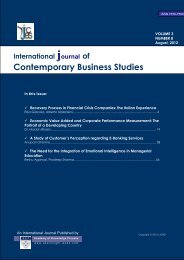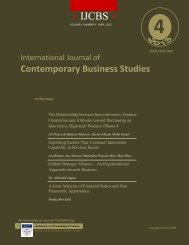Contemporary Business Studies - Academy of Knowledge Process ...
Contemporary Business Studies - Academy of Knowledge Process ...
Contemporary Business Studies - Academy of Knowledge Process ...
You also want an ePaper? Increase the reach of your titles
YUMPU automatically turns print PDFs into web optimized ePapers that Google loves.
International Journal <strong>of</strong> <strong>Contemporary</strong> <strong>Business</strong> <strong>Studies</strong>Vol: 4, No: 2. February, 2013 ISSN 2156-7506Available online at http://www.akpinsight.webs.comKeeping in mind the transaction cost and the resource base view, Tallman and Li (1996) reported thatperformance will vary if international diversification is in non-linear shape. Multinational companiesoperating in a hostile environment there exist a positive relationship between experience diversity andperformance <strong>of</strong> the organization( Luo & Peng).Multinationals incur costs <strong>of</strong> internationalization as well asreap the benefits. Diversification strategy has negative relations with financial performance has beenproved in meta analysis. (Capon, Farley and Hoenig, 1990)Ruigrokand Wagner (2003) reported internationalization as not a sufficient condition for superiorperformance and argue that it is an over simplistic approach to theory building. Whereas researchers ininternational business and IOE normally give emphasis to economies <strong>of</strong> scale and scope (Buckley andCasson 1976; Caves, 1971), researchers in financial economics focused on portfolio diversification and itseffect on companies’ risk-return performance ( Lessard 1976, Levy and Sarnat,1970).Anju (1998), reported that diversification is a common occurrence in Asia, quoting examples <strong>of</strong> theconglomerates <strong>of</strong> India (Tata Group) and South Korean (Hyundai).Recent work such as (Denis et al.,2002; Palich et al., 2000) has studied the value <strong>of</strong> international diversification as a corporate strategy,and its impact on corporate performance.A theoretical literature support can be found that unrelateddiversification <strong>of</strong> a firm leads to affect the performance negatively (Rumelt, 1974; Bettis, 1981;Christensen and Montgomery, 1981; Bettis and Mahajan, 1985).Current research shows thatdiversification in product inversely impact the performance <strong>of</strong> firm (Berger and Ofek, 1995; Denis et al.,1997).Porter (1990) positively identified issue between different nations which decide the competitiveness <strong>of</strong> anation-state, same as a view uphold by Grant (1991). A firm with global diversification economies <strong>of</strong>scale, by placing each chain <strong>of</strong> its value-added chain in the equivalent least-cost country (Kogut, 1985).Internationally diversified firms also enjoy the following benefits (Kim et al., 1993):1. Wide range <strong>of</strong> presence in different markets can save firm from aggressive expansion bycompetition.(Hill& Jones , 1998)2. Firms with wide international diversification has reach in different economies.3. A Firm with international diversification is secure from market thrusts <strong>of</strong> demand and supply.Quantitative research on international diversification and performance has found mixed results. Hitt et al.(1997) studied the U.S firms and taking product diversification as a moderator found U-shapedrelationship between international diversification and performance Geringer et al. (2000) studied theJapanese firms and concluded that IDS does not increase pr<strong>of</strong>it <strong>of</strong> firms but it positively impacts thegrowth <strong>of</strong> the firm. Lee et al. (2003) studied the Korean firms and showed a positive relationship <strong>of</strong> IDSand performance.Pitts and Hopkins (1982) conducted an outstanding review <strong>of</strong> the theoretical and practical issues involvedin measurements. Some early addition <strong>of</strong> Rumelt's work simply circumvented the measurement problemby using the same firms and classifications (Bettis, 1981; Bettis & Hall, 1982). Scholars interested inexamination <strong>of</strong> link among diversification and performance has tried to come up with a new scale thatcombine the conceptuality <strong>of</strong> Rumlet’s scheme and accessibility <strong>of</strong> data based on SIC code.(Palepu,1985).Firms try to expand from their original businesses in new markets and Diversification is a means toachieve those expansion objectives. (Aaker 1980, Andrews 1980, Berry 1975, Chandler 1962, Gluck1985). Research reveals top management to be aggressively engaged in diversification activities. Rumelt(1986)studied fortune 500 companies found that till 1974 only 14 percent firms operated as singlebusinesses and 86 percent operated as diversified businesses.2013©<strong>Academy</strong> <strong>of</strong> <strong>Knowledge</strong> <strong>Process</strong>89
















